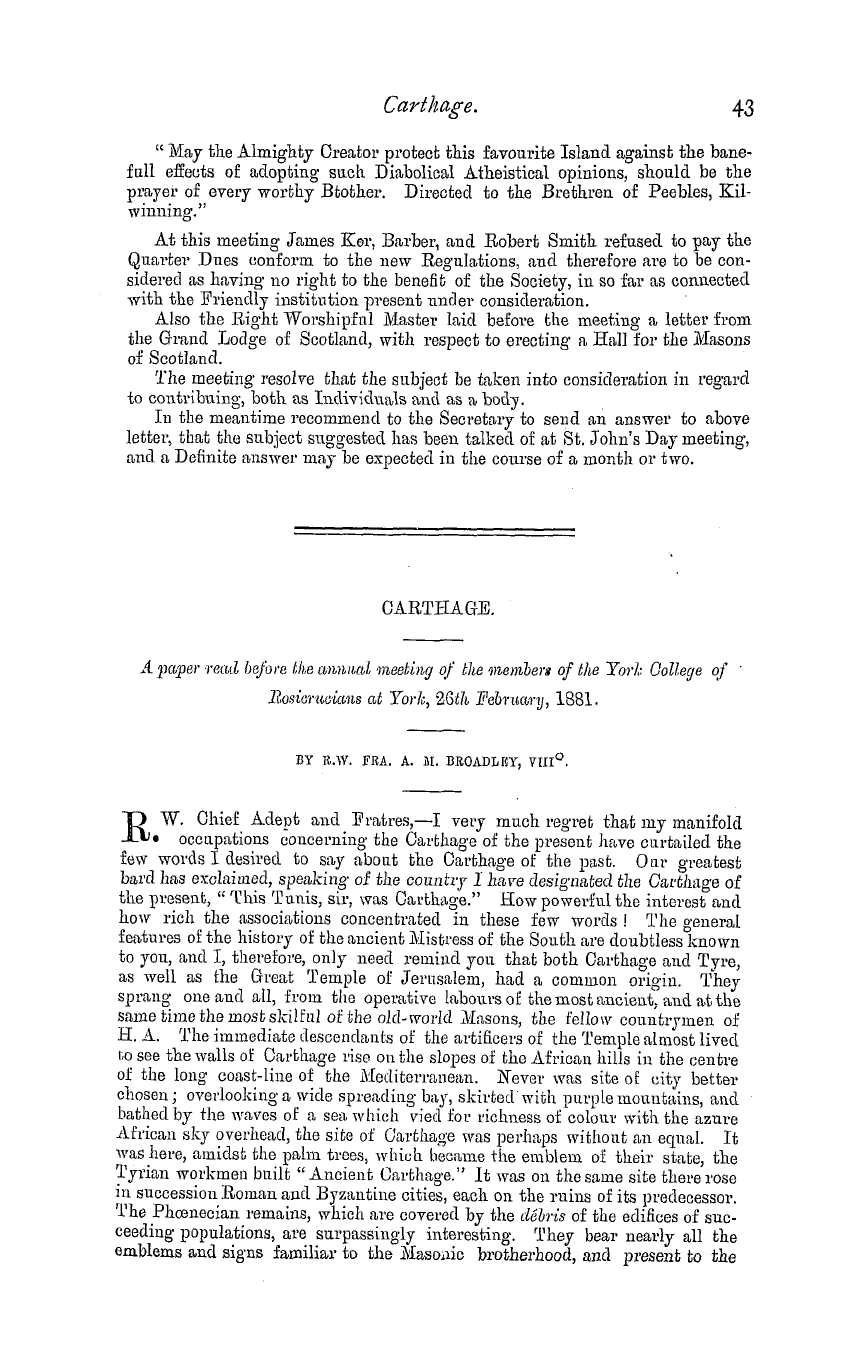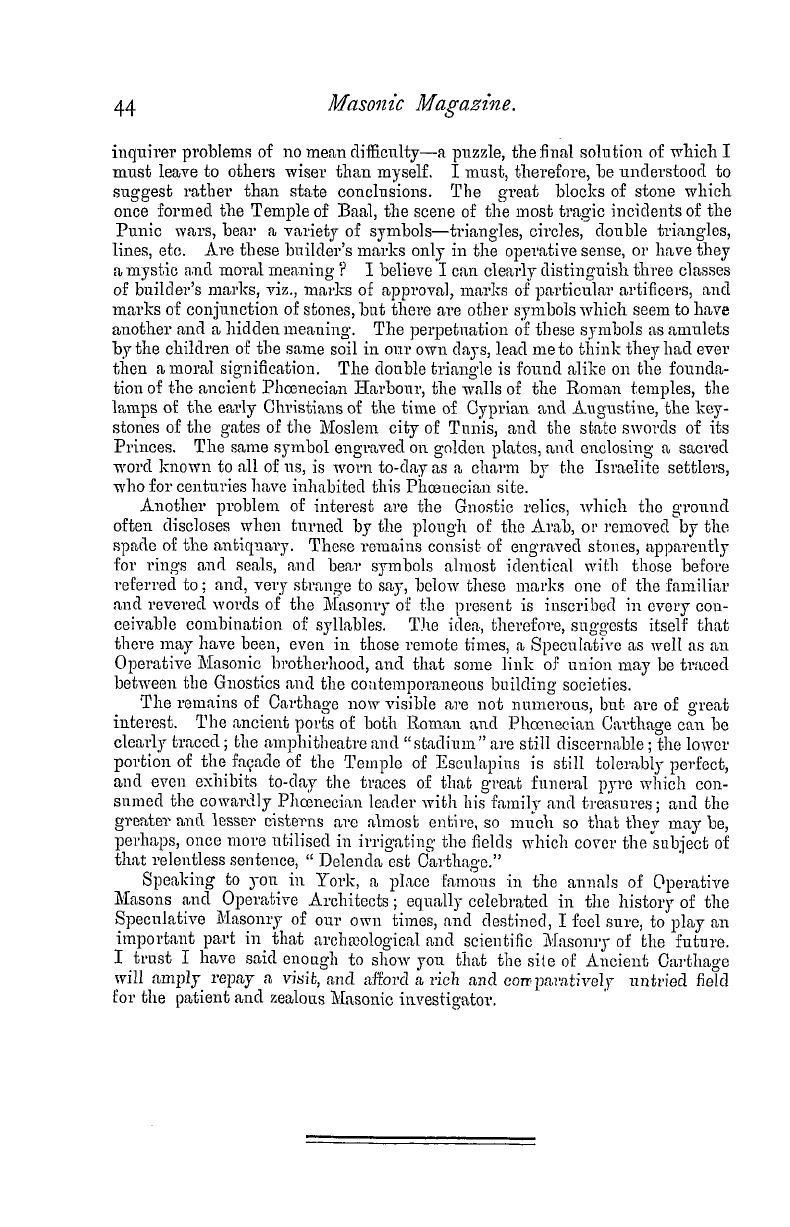Note: This text has been automatically extracted via Optical Character Recognition (OCR) software.
Carthage.
inquirer problems of no mean difficulty—a puzzle , the final solution of which I must leave to others wiser than myself . I must , therefore , be understood to suggest rather than state conclusions . The great blocks of stone which once formed the Temple of Baal , the scene of the most tragic incidents of the Punic wars , bear a variet y of symbols—triangles , circles , double triangles ,
lines , etc . Are these builder ' s marks only in the operative sense , or have they a mystic and moral meaning ? I believe I can clearly distinguish three classes of builder ' s marks , viz , marks of approval , marks of particular artificers , and marks of conjunction of stones , but there are other symbols which seem to have another and a hidden meaning . The perpetuation of these symbols as amulets by the children of the same soil in our own clays , lead me to think they had ever
then amoral signification . The double triangle is found alike on the foundation of the ancient Phcenecian Harbour , the walls of the Roman temples , the lamps of the early Christians of the time of Cyprian and Augustine , the keystones of the gates of the Moslem cit y of Tunis , and the state swords of its Princes . The same symbol engraved on golden plates , and enclosing a sacred word known to all of us , is worn to-day as a charm by the Israelite settlers
, who for centuries have inhabited this Phcenecian site . Another problem of interest are the Gnostic relics , which tho ground often discloses when turned b y the plough of the Arab , or removed b y the spade of the antiquary . These remains consist of engraved stones , apparently for rings and seals , and bear symbols almost identical with those before referred to ; and , very strange to say , below these marks one of the familiar
and revered words of the Masonry of the present is inscribed in every conceivable combination of syllables . The idea , therefore , suggests itself that there may have been , even in those remote times , a Speculative as well as an Operative Masonic brotherhood , and that some link of union may be traced between the Gnostics and the contemporaneous building societies .
The remains of Carthage now visible are not numerous , but are of great interest . The ancient ports of both Roman and Phcenecian Carthage can be clearly traced ; the amphitheatre and " stadium" are still discernable ; the lower portion of the facade of the Temple of Esculapius is still tolerably perfect , and even exhibits to-day the traces of that great funeral pyre which consumed the cowardly Phcenecian leader witli his family and treasures ; and the
greatei * and lesser cisterns are almost entire , so much so that they may be , perhaps , once more utilised in irrigating the fields which cover the subject of that relentless sentence , " Delenda est Carthage . " Speaking to you in York , a place famous in the annals of Operative Masons and Operative Architects ; equally celebrated in the history of the Speculative Masonry of our own timesand destinedI feel sureto lay an
, , , p important part in that archaeological and scientific Masonry of the future . I trust I have said enough to show yon that the site of Ancient Carthage will amply repay a visit , and afford a rich and comparatively untried field for the
patient and zealous Masonic investigator .
Note: This text has been automatically extracted via Optical Character Recognition (OCR) software.
Carthage.
inquirer problems of no mean difficulty—a puzzle , the final solution of which I must leave to others wiser than myself . I must , therefore , be understood to suggest rather than state conclusions . The great blocks of stone which once formed the Temple of Baal , the scene of the most tragic incidents of the Punic wars , bear a variet y of symbols—triangles , circles , double triangles ,
lines , etc . Are these builder ' s marks only in the operative sense , or have they a mystic and moral meaning ? I believe I can clearly distinguish three classes of builder ' s marks , viz , marks of approval , marks of particular artificers , and marks of conjunction of stones , but there are other symbols which seem to have another and a hidden meaning . The perpetuation of these symbols as amulets by the children of the same soil in our own clays , lead me to think they had ever
then amoral signification . The double triangle is found alike on the foundation of the ancient Phcenecian Harbour , the walls of the Roman temples , the lamps of the early Christians of the time of Cyprian and Augustine , the keystones of the gates of the Moslem cit y of Tunis , and the state swords of its Princes . The same symbol engraved on golden plates , and enclosing a sacred word known to all of us , is worn to-day as a charm by the Israelite settlers
, who for centuries have inhabited this Phcenecian site . Another problem of interest are the Gnostic relics , which tho ground often discloses when turned b y the plough of the Arab , or removed b y the spade of the antiquary . These remains consist of engraved stones , apparently for rings and seals , and bear symbols almost identical with those before referred to ; and , very strange to say , below these marks one of the familiar
and revered words of the Masonry of the present is inscribed in every conceivable combination of syllables . The idea , therefore , suggests itself that there may have been , even in those remote times , a Speculative as well as an Operative Masonic brotherhood , and that some link of union may be traced between the Gnostics and the contemporaneous building societies .
The remains of Carthage now visible are not numerous , but are of great interest . The ancient ports of both Roman and Phcenecian Carthage can be clearly traced ; the amphitheatre and " stadium" are still discernable ; the lower portion of the facade of the Temple of Esculapius is still tolerably perfect , and even exhibits to-day the traces of that great funeral pyre which consumed the cowardly Phcenecian leader witli his family and treasures ; and the
greatei * and lesser cisterns are almost entire , so much so that they may be , perhaps , once more utilised in irrigating the fields which cover the subject of that relentless sentence , " Delenda est Carthage . " Speaking to you in York , a place famous in the annals of Operative Masons and Operative Architects ; equally celebrated in the history of the Speculative Masonry of our own timesand destinedI feel sureto lay an
, , , p important part in that archaeological and scientific Masonry of the future . I trust I have said enough to show yon that the site of Ancient Carthage will amply repay a visit , and afford a rich and comparatively untried field for the
patient and zealous Masonic investigator .
















































